Indexed In
- Open J Gate
- Genamics JournalSeek
- Academic Keys
- JournalTOCs
- CiteFactor
- Ulrich's Periodicals Directory
- Access to Global Online Research in Agriculture (AGORA)
- Electronic Journals Library
- Centre for Agriculture and Biosciences International (CABI)
- RefSeek
- Directory of Research Journal Indexing (DRJI)
- Hamdard University
- EBSCO A-Z
- OCLC- WorldCat
- Scholarsteer
- SWB online catalog
- Virtual Library of Biology (vifabio)
- Publons
- Geneva Foundation for Medical Education and Research
- Euro Pub
- Google Scholar
Useful Links
Share This Page
Journal Flyer

Open Access Journals
- Agri and Aquaculture
- Biochemistry
- Bioinformatics & Systems Biology
- Business & Management
- Chemistry
- Clinical Sciences
- Engineering
- Food & Nutrition
- General Science
- Genetics & Molecular Biology
- Immunology & Microbiology
- Medical Sciences
- Neuroscience & Psychology
- Nursing & Health Care
- Pharmaceutical Sciences
Research - (2021) Volume 12, Issue 1
Influence of Sowing Date and Removal of Disease Leaves on the Incidence and Severity of lLeaf Spot Disease in Telfairia occidentalis
Kpu Andrew Kebei*, Mbong Grace Annih and Agyingi Lucy AmbangReceived: 11-Jan-2021 Published: 29-Jan-2021, DOI: 10.35248/2157-7471.21.12.535
Abstract
Diseases of fungi origin are important diseases of Telfairia occidentalis (fluted pumpkin) in the main growing areas of the leafy vegetable in Cameroon. A study was conducted between March and June in the cropping seasons of 2019 and 2020 in Dschang to determine the influence of sowing date and removal of diseased leaves on the incidence and severity of leaf spot disease caused by Phoma sorghina. There were four sowing dates, with no variation in planting distance in the two cropping seasons. The experiment was laid out in Randomized Complete Block Design (RCBD) with three replications. Each replication had three experimental units with similar sowing dates. Seeds were sown at the rate of 1 m × 1 m, with four seeds per experimental unit. Data for disease incidence and severity was recorded every fortnight, commencing three weeks after emergence (WAE) and for a period of eight weeks for each sowing date. Disease incidence and severity was determined using Microsoft Excel and the data was subjected to statistical analysis and the means separated by Duncan Multiple Range Test (DMRT) at 95% confidence interval. Analysis of variance revealed that there was a significant difference (p ≤ 0.05) in leaf spot disease incidence between sowing date two and sowing dates one, three and four. Sowing date four recorded a very high leaf spot disease incidence (22.464 ± 16.718) and severity (1.625 ± 0.836). The first cropping season registered a higher and significant (p ≤ 0.05) leaf spot disease incidence and severity compared to the second cropping season.
In order to enhance production of leaves, and reduced disease incidence and severity of Telfairia occidentalis, sowing date two (corresponding to the first week of April) besides removal of diseased leaves every fortnight could well manage leaf spot disease compared to sowing dates one three and four.
Keywords
Telfairia occidentalis; Sowing date; Removal; Incidence; Severity
Introduction
Telfairia occidentalis Hook. f. is a perennial vine of the cucurbit family. The plant is commonly known in Cameroon for its highly prized dark green leaves. Freshly harvested leaves are often prepared as an important delicacy in several households and cuisines. The leaves are a reservoir of novel compounds, minerals, and vitamins with important advantages for human health and body development [1]. This leafy vegetable is also used as a food supplement [2] with compelling medicinal properties [3].
Despite the immense economic importance of the vegetable to the rural population of Cameroon, and its role in enhancing human nutrition and health the sustained production of the crop still remains a daunting due to poor soils, drought, insect pest and disease. The diseases more frequently result from attack by fungi and varying symptoms amongst which are generally: powdery mildew, soft rot, mottling, stunting and chlorosis. The fungus, Phoma sorghina, a ubiquitous facultative phytopathogen attacks the leaves of the crop and produces localized lesions of dead or collapsed cells with the effect of reducing the leaf lamina. This has the effect of curtailing production of the leafy vegetable and degrades its quality. Infection of leaves by the pathogen significantly reduces the nutrient content [4]. Phoma sorghina is increasingly becoming an important food crop pathogen, being equally associated with food contamination in bananas and cereals.
Nwufo and Ihejirika [5], reported that leaf spot disease of Telfairia occidentalis can be managed by spraying with fungicides at every forth night. Nonetheless, chemical control of plant diseases is of potential danger to man, non-target beneficial organisms and the environment [6] and can also result in residual chemicals in food [7]. Given the fact that the use of chemicals cannot be precluded as a method for disease control, the cost of these chemicals and their long term effects or consequences on the natural ecosystem [8], expertise [6], and it high cost requires that other control measures should be investigated.
In Cameroon, Telfairia occidentalis is often cultivated during the onset of the rainy season between the months of March and April but information on the management strategies of leaf spot disease of Telfairia occidentalis leave much to be desired. Though some studies have been carried out, there is still need to investigate other management techniques in order to ascertain the most efficient and effective leaf spot management strategy. In order to close this gap and improve on the quality of the crop, there is need to further investigation on low input management strategies.
The experiment was conducted to investigate the influence of sowing date and removal of diseased leaves on the incidence and severity of leaf spot disease of Telfairia occidentalis.
Materials and Methods
Location of study site
The study was conducted in the Dschang in 2019 and 2020 cropping seasons. Dschang is the headquarters of the Menoua Division which lies on latitude 5°26′38″N and longitude 10°03′11″E. [9] with an equatorial monsoon climate. Menoua Division is one of the eight Divisions in the West Region of the Republic of Cameroon. The Division constitutes one of the main crop-producing areas in the Western Highlands agro-ecological zone of Cameroon. This region is known to carry out intensive crop farming even though the fertility of the soil is constraint [9]. Telfairia occidentalis is cultivated in this region is by some few individuals. Dschang is characterized by an average annual temperature of 20.4°C, high annual relative humidity of 83% and a mean annual rainfall of 1936 mm [10]. The wettest month is September with an average of 244.6mm of rain. The locality has two main seasons, the dry and rainy seasons. The dry season begins late into November and ends with the coming of the rains in mid-March. June is the hottest month with an average temperature of 21°C and the coldest is July at 18°C [9] (Figure 1).
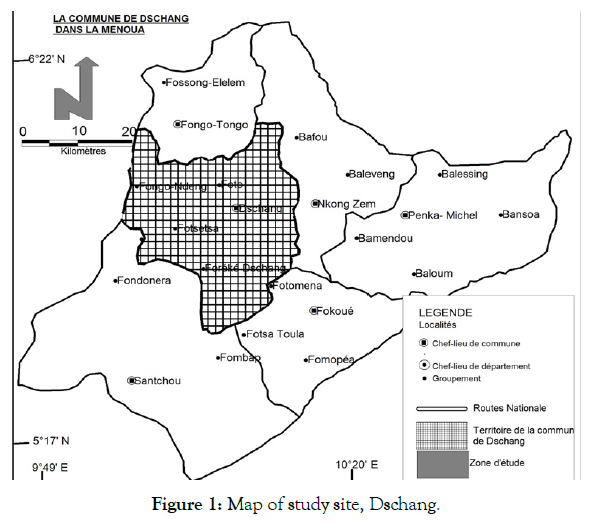
Figure 1: Map of study site, Dschang.
Experimental design
The experiment was laid out in a Randomized Complete Block Design (RCBD) with 36 experimental units laid out in three blocks; each with twelve experimental units (Figure 2). Each block has three plots with identical sowing dates. The experiment was laid out over a surface area of 121 m2 (11 m × 11 m). Each experimental unit measured 1.5 m × 1.5 m. Plots and blocks were separated by an alleyway of 0.4 m (Figure 2).
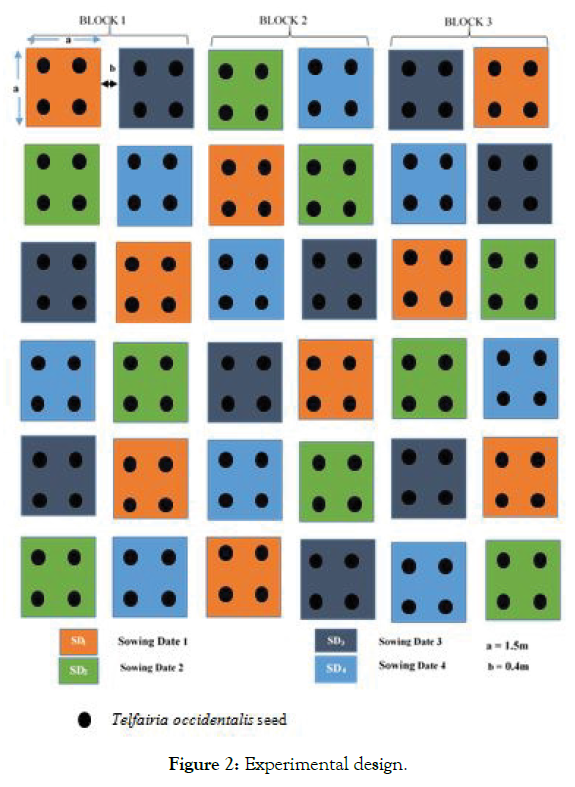
Figure 2: Experimental design.
Land preparation and establishment of the crop
At the commencement of each cropping season, the field was manually cleared and debris removed. The field was tilled and thirty six experimental units were marked out and mounds constructed. Mature and healthy Telfairia occidentalis seeds were acquired from the farm of this researcher in Dschang. All experimental units were identified with distinctive labels.
Four seeds were hand sown on each experimental unit at the depth of 3cm and at the rate of 1m × 1m. Four sowing dates were chosen at an interval of seven (7) days on the selected plots (3 plots per replicate). First sowing was on the 28th of March of each year while the second third and fourth sowing were on the 4th, 11th and 18th of April respectively within this study period.
Staking was carried out three weeks after emergence (WAE) and weed removal was carried out manually at regular intervals to ensure sustainability of the crop in the field. Bamboo trellises at a height of 1m were constructed over each experimental unit to serve as support for the climbing vine and for better disease assessment on the field.
Data Collection
Disease assessment on the experimental plots: Disease incidence on the field was ascertained by visual observations of symptoms of leaf spot. Data for disease incidence was collected for a period of eight weeks beginning three weeks after emergence (WAE). The total number of leaves on each plant was counted and the information documented. Leaves showing symptoms of leaf spot were removed, counted and the information equally registered.
Calculations for disease incidence: The data for disease incidence (DI) was gotten by calculating the percentage of the proportion of leaves infected per plant and per plot within the speculated period using the following formula:
Percentage DI = (Number of leaves infected/Total numberof leaves sampled) × 100
Determination of disease severity: The disease severity commenced immediately after the assessment of the disease incidence and different treatments were same as for disease incidence. The formula for leaf spot disease severity (DS) is given by:
% DS = (Area of leaf tissue infected/ Total area of leaf sampled) × 100
Due to the unwieldy nature of the above equation, the disease severity was assessed based on the percentage disease incidence (proportion of diseased leaves per plant) following the modified disease severity scale as follows (Table 1).
| Severity Scale | Numerical Rating | Description of symptom |
|---|---|---|
| 0 | 0 | No disease. |
| 1 – 20 | 1 | Infection of the leaves with small spot lesions. |
| 21 – 40 | 2 | Moderate infection of leaf spot lesions spreading on the surface of the leaves. |
| 41 – 60 | 3 | Severe infection of the leaves with leave spot lesions almost found in all the leaflets. |
| 61 – 80 | 4 | Very severe infection on all the leaves with spot lesions spreading in all the leaflets and coalescing. |
| 81 – 100 | 5 | The entire plant are completely infected with all leaves having leaf spot disease, some of the leaves having holes and there is leaf tearing. |
Table 1: Disease severity scale of leaf spot (scored at weekly interval).
Statistical Analysis
All data collected were input into Microsoft Excel for calculations involving leaf spot disease incidence and disease severity and the data was analyzed using the statistical package for social sciences (SPSS) version 23. An analysis of variance (ANOVA) was carried out and the means separated using Duncan Multiple Range Test (DMRT) for statistical significance at 95% confidence interval (p0.05).
Pearson correlation analysis was used to determine the relationship between leaf spot disease incidence and severity.
Results
Leaf spot disease incidence and severity at sowing dates
In spite of the cropping season, the leaf spot disease incidence of Telfairia occidentalis leaves witnessed a drop from sowing date one (18.64 ± 11.841) to sowing date two (13.631 ± 11.978), with a very low incidence. Disease incidence then increased progressively through sowing date three (17.501 ± 11.987) to sowing date four (Figure 3). Statistical analysis unveiled that there was a significant difference between sowing date two (SD2) and sowing dates and sowing dates three (SD3), one and four. Sowing dates one and three recorded no significant difference while there was a significant difference between sowing date four (SD4) and sowing date three and one (Table 2 and Figure 3).
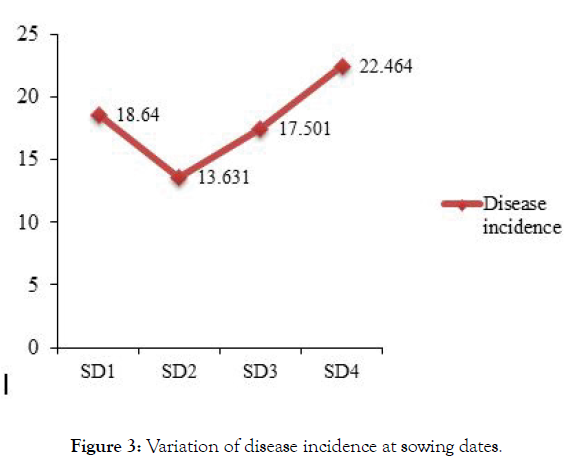
Figure 3: Variation of disease incidence at sowing dates.
| Sowing date (SD) | Disease incidence |
|---|---|
| SD2 | 13.631 ± 11.978a |
| SD3 | 17.501 ± 11.987b |
| SD1 | 18.640 ± 11.841b |
| SD4 | 22.464 ± 16.718c |
Table 2: Disease incidence at sowing dates.
Regarding disease severity, there was a downswing in disease severity from sowing date one to two, with a very low disease severity (1.042 ± 0.740). Disease severity later increased stepwise from sowing date two via sowing date three to four, which recorded a very high disease severity (1.625 ± 0.863), (Figure 4). Significant differences were registered between sowing dates two and sowing dates one, three and four. There was a significant difference between sowing date one and four but comparable to sowing date three. Sowing dates three and four recorded no significant differences (Table 3).
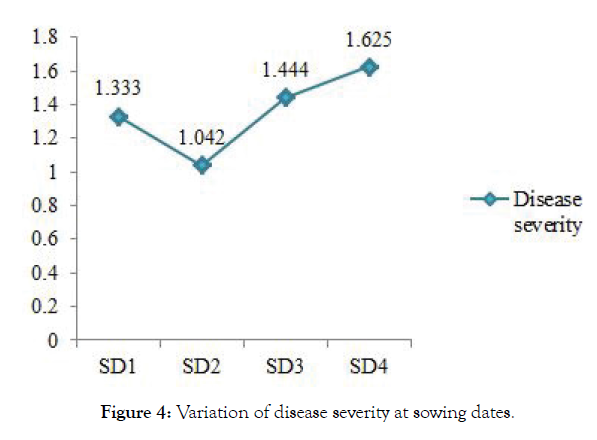
Figure 4: Variation of disease severity at sowing dates.
| Sowing date (SD) | Disease severity |
|---|---|
| SD2 | 1.042 ± 0.740a |
| SD1 | 1.333 ± 0.671b |
| SD3 | 1.444 ± 0.554bc |
| SD4 | 1.625± 0.836c |
Table 3: Disease severity at sowing dates.
Leaf spot disease incidence and severity at cropping seasons
Disease incidence was higher in the first cropping season compared to the second (Figure 5). In the first cropping season of this study, a high leaf spot disease incidence (25.782 ± 13.856) was registered compared to that observed in the second cropping season (10.336 ± 7.671). Statistical analysis revealed that the values were significant at p ≤ 0.05 (Tables 4 and 5).
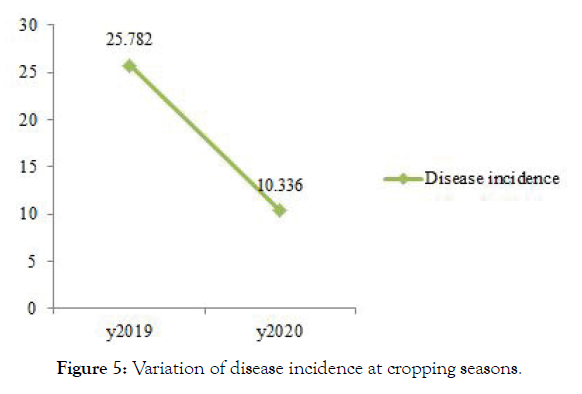
Figure 5: Variation of disease incidence at cropping seasons.
| Cropping season | Disease incidence |
|---|---|
| 2019 | 25.782 ± 13.856a |
| 2020 | 10.336 ± 7.671b |
Table 4: Disease incidence at cropping seasons.
| Cropping season | Disease severity |
|---|---|
| 2019 | 1.772 ± 0.806a |
| 2020 | 1.00 ± 0.443b |
Table 5: Disease severity at cropping seasons.
There was a comparatively high disease severity in the first cropping season to the second. The values obtained were significant at p ≤ 0.05 (Figure 6).
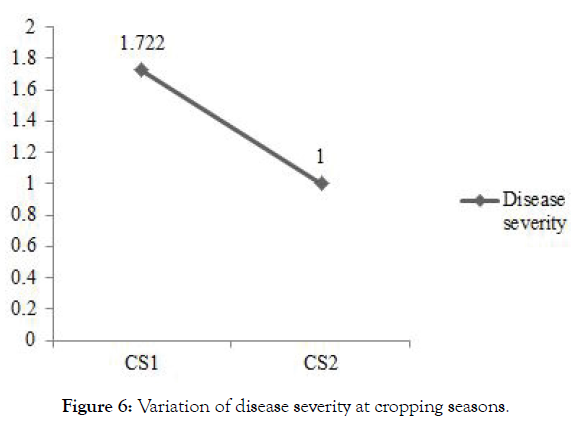
Figure 6: Variation of disease severity at cropping seasons.
Disease incidence and severity at sowing dates based on cropping season
Disease incidence was generally higher in the first cropping season of this study compared to the second across all sowing dates (Figure 7). At the first cropping season, disease incidence plummeted from sowing date one to two and increased steadily through sowing date three to sowing date four sowing date four witnessed the peak (33.1814 ± 15.442) for disease incidence while sowing date two revealed a very low disease incidence (16.9383 ± 14.789) (Table 6).
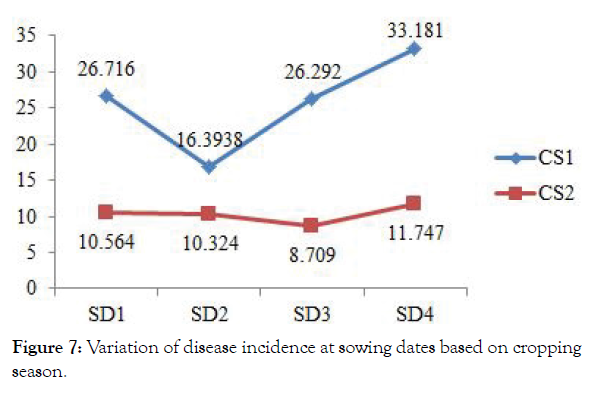
Figure 7: Variation of disease incidence at sowing dates based on cropping season.
| Sowing date | Cropping season | Disease incidence |
|---|---|---|
| SD1 | 2019 | 26.716 ± 9.464 |
| 2020 | 10.5634± 7.789 | |
| SD2 | 2019 | 16.9383 ± 14.789 |
| 2020 | 10.3244 ± 7.060 | |
| SD3 | 2019 | 26.2922 ± 9.983 |
| 2020 | 8.7092 ± 5.731 | |
| SD4 | 2019 | 33.1814 ± 15.442 |
| 2020 | 11.7467 ± 9.603 |
Table 6: Disease incidence at sowing dates based on cropping season.
At the second cropping season, there was a narrow decline in disease incidence from sowing date sowing day two. Disease severity reduced at sowing date three but sowing date four witnessed an increase in severity from sowing date three (Figure 7).
There was a gentle increase in incidence from sowing date three to four a very low disease incidence (8.7092 ± 5.731) was registered at sowing date three while sowing date four recorded a very high value for disease incidence (11.7467 ± 9.603) (Table 6).
Between the cropping seasons, disease severity was generally higher in the first cropping season compared to the second across all sowing dates (Figure 8). At the first cropping season, disease incidence plunged from sowing date one to two and increased sharply to sowing date three and gradually to sowing date four. A very low severity was observed at sowing date two (1.167 ± 0.91) while sowing date four (2.111 ± 0.854) recorded a very high disease severity (Table 7).
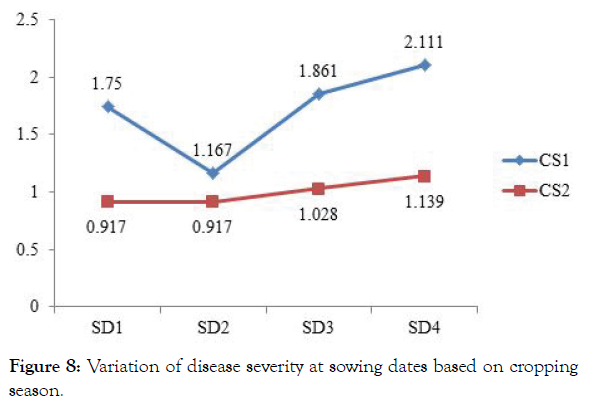
Figure 8: Variation of disease severity at sowing dates based on cropping season.
| Sowing date | Cropping season | Disease severity |
|---|---|---|
| SD1 | 2019 | 1.750 ± 0.604 |
| 2020 | 0.917 ± 0.439 | |
| SD2 | 2019 | 1.167 ± 0.91 |
| 2020 | 0.917 ± 0.5 | |
| SD3 | 2019 | 1.861 ± 0.487 |
| 2020 | 1.028 ± 0.167 | |
| SD4 | 2019 | 2.111 ± 0.854 |
| 2020 | 1.139 ± 0.543 |
Table 7: Disease severity at sowing dates based on cropping season.
At the second cropping season, severity was constant for sowing dates one and two (0.917 ± 0.439 and 0.917 ± 0.5 respectively). An increase in disease severity was witnessed from sowing date two across sowing date three to sowing date four (Figure 8). The lowest severity was observed at sowing dates one and two while sowing date four depicted the highest disease severity (1.139 ± 0.543) (Table 7).
Discussion
Telfairia occidentalis leaf spot disease incidence and severity was very low and significant at sowing date two compared to other sowing dates in this study. This could be attributed to the fact that the growing stage was less susceptible to new infections resulting in disease escape, reduced inoculum levels due to removal of diseased leaves every fortnight and luxuriant vegetative growth. Plants do not respond quickly to disease attack with luxuriant growth because they are physiologically and metabolically very active and therefore have greater ability to withstand the pathogen and suppress disease development.
Sowing date four recorded a very high leaf spot disease incidence and severity compared sowing dates three, one and two. This could be due to relatively high inoculum built up from sowing dates, three one and two and that the growing stage was more vulnerable to infection by the fungi pathogen. Sowing date four was characterized by very sparse vegetative growth which replicated to fewer leaves. This could have been responsible for the very high leaf spot disease incidence and severity at this sowing date compared to all others. As the existing foliage grew older and older with time, they became more susceptible to infection by Phoma sorghina. This suggests that the susceptibility of the plants to the fungi infection was heightened when the plants became older. With fewer leaves, new infections were inevitable despite removal of diseased leaves. These results are in agreement with Nahoua et al. [11] who reported that viral disease incidence increased with the increase in growth stage of curcubits under field conditions. Similar observations were made by Ilondu [12] with respect to infections by Cochlobolus lunatus, Fusarium solani, and other fungi isolates responsible for leaf spot disease of Ipomoea batatas.
Disease severity was generally characterized by infection of leaves with small spot lesions. This could be ascribed to the fact that diseased foliage was removed fortnightly. This prevented high inoculum build up which minimized the rapid spread of infection. These results are in accord with Nwufo and Ihejirika [5] who reported that removal of diseased leaves from Telfairia occidentalis intercropped with other crops significantly reduced leaf spot disease severity.
There was a significant difference in leaf spot disease incidence and severity in the first and second cropping season. This could be due to climate variability which favoured the development and spread of the disease on the field in the first cropping. Marine reported that increase in temperatures generally increases rates of fungal growth and reproduction and extends the reproductive period resulting in more generations within a given time frame. Moreover, Mbong et al., [7] reported that climatic changes are known to affect pathogen development and survival rates with possible modification of host susceptibility that could lead to changes in the impact of diseases on food crops. The authors went further to highlight that climate change may affect not only the optimal conditions for infection but also host specificity and mechanisms of plant infection. In addition, Yanez-Lopez et al., [13] intimated that climate influences the incidence as well as temporal and spatial distribution of plant diseases. Phoma sorghina is a necrotrophic pathogen that secretes enzymes that kill leaf tissue, extract nutrients from the cells and then live in the dead tissue. Therefore, all climatic factors that cause or accelerate tissue death, such as high temperatures, could favour high leaf spot disease incidence and severity as was the case in 2019.
Conclusion
For very low leaf spot disease incidence and severity, sowing date two alongside removal of diseased leaves every fortnight proved to be better. These cultural disease management techniques can therefore be adopted by cultivators to enhanced large scale and healthy production of leaves of Telfairia occidentalis. Low input technologies of this sort are inexpensive to poor cultivators and vital for self-sufficiency in the production of quality Telfairia occidentalis leaves.
REFERENCES
- Temitope OR, Olugbenga OO, Erasmus AJ, Jamilu I, Shehu MY. Comparative study of the physicochemical properties of male and female flutted pumpkin (Telfairia occidentalis). J Med Res. 2020;6(2):55-61.
- Odiaka NI, Schippers RR. Telfairia occidentalis Hook f. [Internet] Record from PROTA4U. PROTA (Plant Resources of Tropical Africa). 2004.
- Kayode AA, Kayode OT. Some medicinal values of Telfairia occidentalis: A review. Am J Biochem Mol Biol. 2011;1(1):30-38.
- Udo SE, Osai EO, Umana EJ, Markson AA, Madunagu BE. Infection Related Changes in Nutritional Contents of Fluted Pumpkin (Telfairia occidentalis) Infected by Diplocossum spicatum and Control Using Plant Extracts. Int J Res App Nat Soc Sci. 2013;1:29-36.
- Nwufo MI, Ihejirika GO. Influence of inter-cropping and removal of diseased leaves on incidence and severity of leaf spot disease of Telfairia occidentalis Hook f. caused by Phoma sorghina. Life Sci J. 2008;5(2):81-83.
- Osai EO, Udo SE, Okoli CE, Bemoh BE. Comparative efficacy of three plan extracts for the control of leaf spot disease in fluted pumpkin (Telfairia occidentalis Hook F.). J Biol Agri Heal care. 2017;7:12.
- Grace MA, Achick TF, Bonghan BE, Bih ME, Ngo NV, Ajeck MJ, et al. An overview of the impact of climate change on pathogens, pest of crops on sustainable food biosecurity. Int J Ecotoxicol Ecobiol. 2019;4:114-124.
- Godwin-Egein MI, Okereke VC, Justus OP. Effect of fluted Pumpkin (Telfairia occidentalis) and Maize (Zea mays) intercrop on leaf spot disease. Am J Agri Sci. 2015;2(4):133-137.
- Kome GK, Enang RK, Bine FK. Climate Change, Soil Fertility Management and the Nexus: A Knowledge and Opinions Study in Western Cameroon. J Sci Res Rep. 2017;24:1-6.
- Plan Communal De Développement De Dschang. Action pour un Développement Equitable, Intégré et Durable (ADEID). 2011.
- Kone N, Asare-Bediako E, Silue S, Kone D, Koita O, Menzel W, et al. Influence of planting date on incidence and severity of viral disease on cucurbits under field condition. Ann Agri Sci. 2017;62(1):99-104.
- Ilondu EM. Etiology and assessment of leafspot disease of sweet potato (Ipomoea batatas (L.) Lam) in selected farms in Delta State, Nigeria. Agriculture and Biology Journal of North America. 2013;4(4):476-84.
- Yanez-Lopez R, Torres-Pacheco I, Guevara-González RG, Hernández-Zul MI, Quijano-Carranza JA, Rico-García E. The effect of climate change on plant diseases. Afr J Biotechnol. 2012;11(10):2417-2428.
Citation: Kebei KA, Annih MG, Ambang AL (2021) Influence of Sowing Date and Removal of Disease Leaves on the Incidence and Severity of lLeaf Spot Disease in Telfairia occidentalis. J Plant Pathol Microbiol 12:535.
Copyright: © 2021 Kebei KA, et al. This is an open-access article distributed under the terms of the Creative Commons Attribution License, which permits unrestricted use, distribution, and reproduction in any medium, provided the original author and source are credited.

